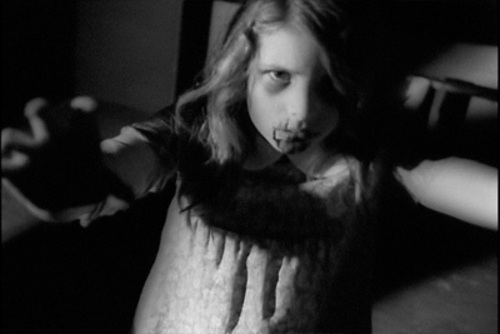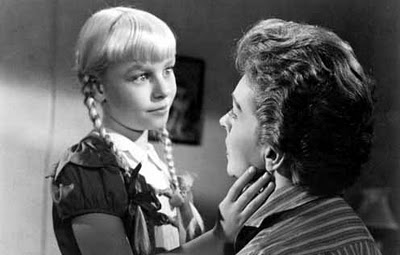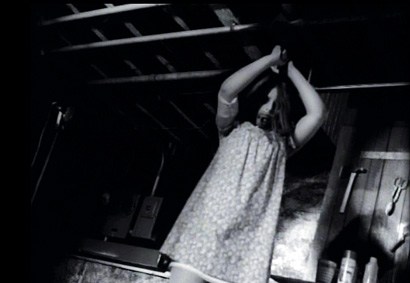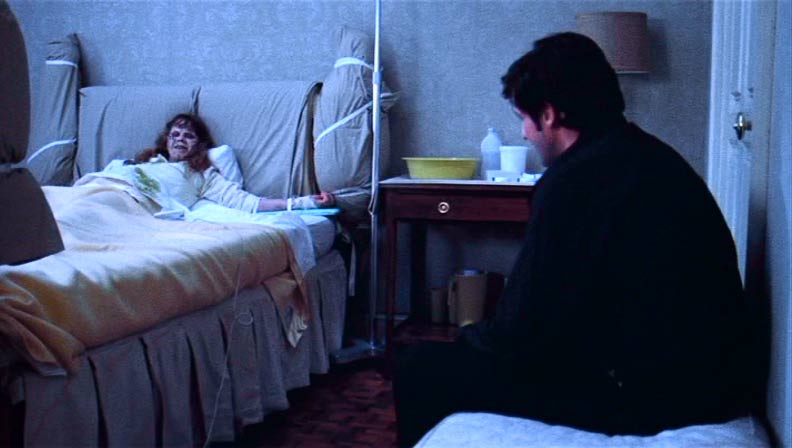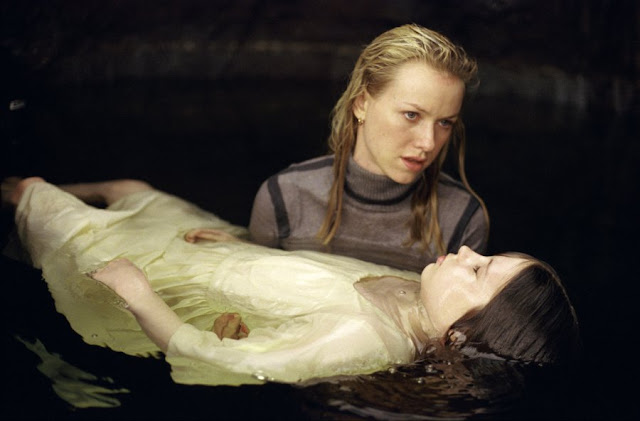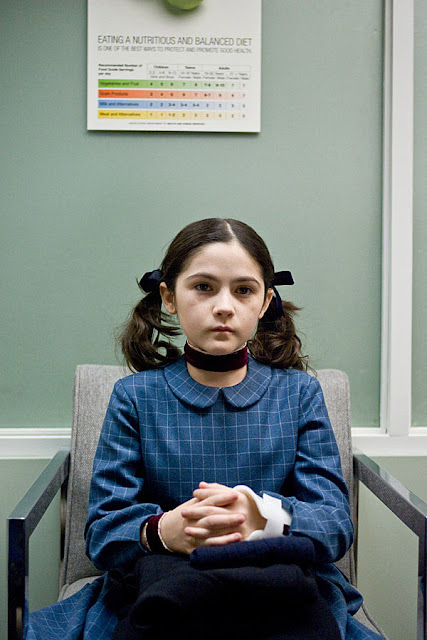This guest post by Julia Patt appears as part of our theme week on The Terror of Little Girls.
Kyra Schon had exactly one line—“I hurt”—and less than ten minutes of screen time in George Romero’s original Night of the Living Dead. Much of her role consisted of lying supine on a table. Her big scene happened 84 minutes into a 95-minute film. Her character is not a perennial favorite on the creepiest kids in cinema lists. (Although when she does appear, she’s No. 1.) But before Regan MacNeil showed us her infamous head-spinning trick, before Damien took the world’s most sinister tricycle ride, and before Samara hauled herself out of the television and into our nightmares, there was little Karen Cooper, who ate her dad and stabbed her mom with a garden trowel.

It’s impossible to understand Karen without discussing her parents, Harry (Karl Hardman) and Helen (Marilyn Eastman); initially, her family is all that gives her context in Romero’s strange new world. But the Coopers always bothered me in Night of the Living Dead. They didn’t seem to belong. After all, almost half the film passes before they appear. Ben (Duane Jones), our protagonist, has spent a good chunk of screen time securing an abandoned farmhouse against the undead. All the stuff you want a good survivor to do, he does: barricade the doors and windows, look for supplies, and settle the nearly catatonic survivor-girl Barbra (Judith O’Dea) on the sofa. Forty minutes in and we’re all ready to weather the long night of Romero’s undead apocalypse.
And then the Coopers emerge from the cellar snarling with metaphorical significance—i.e., the nuclear family staggers out of the underworld to reassert its importance. We’re what you’re meant to defend, they seem to say. Of course, their presence also highlights the awful truth of any zombie apocalypse film: there are no safe places.
If the dead don’t overrun a stronghold, you will have to deal with the living eventually.

By the way, good luck if the living you have to deal with is Harry Cooper. He’s all the worst characteristics of the patriarchy packaged and amplified: aggressive, entitled, self-centered, oddly petulant, and arrogant. He won’t apologize for not coming up to help, despite hearing Barbra’s screams. Instead, he lashes out at Ben for criticizing him. When the others refuse to join him in the cellar, he throws a temper tantrum. He’ll board up that door and leave them to rot, understand? Moments later, he furiously demands they share the supplies Ben’s scavenged from the house. “We’ve got to have food down there,” Harry blusters. “We’ve got a right.” Helen, his wife, is not much more compelling. Bitter and cynical, she can’t resist poking at her husband’s neuroses:
“That’s important, isn’t it?”
“What?”
“To be right and for everyone else to be wrong.”
We know from just a few lines of dialogue that this is no close-knit couple or loving family, for all that its structure might evoke white picket fences and suburban houses. (Note: it’s unclear where the Coopers come from, but they seem neither rural nor urban.) And in case we miss the point, Helen sums up their situation this way: “We may not enjoy living together. But dying together isn’t going to solve anything.”

The crumbling cement in this relationship is the injured little girl lying on the table downstairs. Her parents are united only on the question of her safety. Unsurprisingly, Karen has no voice or agency of her own. The adults perceive her as entirely helpless— “Maybe it’s shock,” her mother says of her condition. “She can’t possibly take all the racket…” her father objects to bringing her upstairs. She is, they believe, the thing to be protected, shielded from the horror of the events outside. Like the house itself, if they can get her through the night, it will all be OK.
What no one understands in Romero’s first film is, of course, that the undead have already infected Karen. While audiences of Dawn of the Dead and every zombie movie after know that a bite is a death sentence, the characters in Night of the Living Dead haven’t fully realized what they will have to sacrifice. The news reports in the background that families “will have to forgo the dubious comfort of a funeral.” But the problem is much more insidious and frightening: families will have to forgo the comfort of family in order to survive.
It only takes a brief moment of contact for the Coopers to lose Karen. And no amount of hand-holding or parental influence will undo the contamination. While many debate the extent to which Night of the Living Dead is a political allegory, Romero has repeatedly stated he wanted the film to capture the social unrest of the 1960s. Once exposed to the chaos of the world outside, Karen is irrevocably changed. She is about to become part of the danger. Only Ben seems at all cognizant of the fact that she may pose a threat to them. “Who knows what kind of disease those things carry,” he points out when her parents acknowledge that she’s been bitten.

Until the end of the film, Karen remains what she seems: a sick little girl. She dies and rises amidst the chaos of the house being overrun by the undead. After a struggle, Ben shoots Harry, who went for his gun. Harry stumbles down to the cellar and staggers towards his little girl, hand outstretched in what should be a touching scene between parent and child. The next time we see the two of them, Karen crouches over her father—now dead or unconscious— a handful of meat in her hands and his blood on her lips. She does not need his affection, but she will take sustenance from him.

Helen finds them this way and, having drawn Karen’s attention, backs into a corner, horrified. Karen advances and then stabs her mother with a garden trowel in an almost surreal, Hitchcockian sequence. Helen is helpless against her undead daughter. All she can say is “baby,” which Karen does not acknowledge or recognize. Her murder of her mother is ultra-violent; she deals several blows to Helen’s abdomen, thus destroying the origin of her own life.

The film and the scene disturbed audiences to no end, and Karen Cooper has become one of the iconic images of Romero’s films. As said, her moment is brief. Yet, it sticks with us. If we compare Karen to the other women in the film, she initially does not seem unlike Barbra, who is mostly helpless and overwhelmed. She must depend on the others for her survival; alone, she wouldn’t make it. Predictably, these young women are fragile, delicate, and need protection. They are not meant for the horrors outside the house.
This appears to be true up until Karen’s point of resurrection. Where Barbra is devoured, Karen is transformed. Unlike her parents, who are trying to hold onto the old social norms, or Ben, who will do anything to survive, Karen joins the restless mob of the undead. Not consciously or willfully, it’s true, but the end result is the same. Although briefly a victim, she becomes the monster and destroys the remains of her family. She cements her status as a member of the undead by consuming her father and increases their numbers by murdering her mother. These two acts definitively separate her from humanity. She neither wants nor needs the shelter of the family unit.

What’s subversive about Karen Cooper, then, is that she doesn’t just die. In the eyes of society, a good, innocent little girl would simply perish when she encounters something so monstrous. Instead, she joins it. Embodied in her, the new generation does not save us or give us hope. Rather, they become part of the chaos. And no amount of reasoning or pleading will sway them.
Julia Patt is a writer from Maryland. She also edits 7×20, a journal of twitter literature, and is a regular contributor to the Tate Street High Society literary blog. Follow her on twitter: https://twitter.com/chidorme
